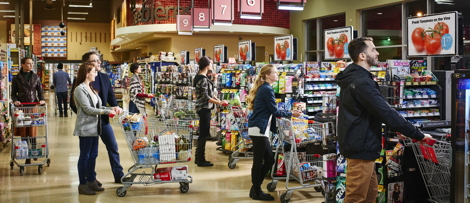Gail Chiasson, North American Editor
Montreal-based Impax Media recently undertook concept and attitude studies in both the US and Canada that reveal how grocery shoppers perceive and use, or would use, digital signage in grocery stores.
For the most part, the US and Canadian studies are similar, barring what consumers see as their main frustration in grocery shopping. The studies were conducted by Millward Brown, and the material also contains input from IPSOS.
“We’ll be using them for our sales staff to explain the value of Impax Media to grocery retailers,” says Bill Ketcham, executive vice-president and chief marketing officer of Impax Media. Impax offers signage at checkout counters in grocery stores. The signs are on arms that come down to block cashier aisles that are not in use, making for a tidier-looking store while also offering security signals to avoid theft.
“A lot of the facts confirmed with the studies we already knew, but there were some surprises,” says Ketcham, who said he had had a similar study done in his former position heading marketing for Adspace Mall Networks, which proved invaluable for sales staff.
“Grocery retailers today are looking for ways to drive sales and engage with their customers,” says Ketcham. “One of the things we looked at was the various frustrations shoppers have about grocery shopping. Topping the list in the US is the long wait in check-out lines – which averages about four-and-a half minutes – followed in order by the high pricing and ‘out of stock’ items. In Canada, the high pricing came out on top (a reflexion on the low Canadian dollar), followed by ‘out of stock’ and, third, the long waits for checkout (which average about three minutes in Canada).
The study shows that digital signage in stores reduced the perceived wait time in check-out lines by 35%, and also shows that digital signage is 34% more effective than static signs in the stores.
When shoppers in the US were asked about the liklihood of looking at screens while in checkout lines, 70.2% of respondents said that they would definitely look at them, rising to 85.9% for interest when the ‘not sure’ group was factored in.
In Canada, where some stores already have Impax screens, consumers not only found that they reduced the perceived wait time in lines, but that they found them entertaining to watch (85%) and attracted their attention while shopping. The screens can be seen as shoppers manoeuvre up and down store aisles.
The studies also looked at the type of content that shoppers liked or wanted to see on the screens. Topping the list was ‘what’s on sale’, followed, in order, by the weather; special events coming up in the stores; new services in the store; local community events; recipe ideas and news highlights. Of less interest were things like beauty and fashion tips, celebrity news, business news and sports.
“Something that we found consumers and retailers want is for the screens to carry the retailers own brand name,” says Ketcham. “A grocer’s brand has power. They want to be known as (for example only) Metro TV or Safeway TV. Having their own proprietary name would help them engage with the customers. Impax would be the company behind it but the grocery chains would be identified as having their own specific ‘TV’ network.
“This makes sense, so we are building our content strategy around it.”
And it makes sense, since the ‘what’s on sale’ part of the screens’ four-minute loop is handled directly by the retailer with the manufacturer – and gives the retailer 100% of any revenue generated by the grocer by sale of these spots to the manufacturer. The grocer also decides what in-store events, community happenings and more go on the loop. Impax itself sells advertising on 50% of the ad loop.
Impax manages the content production, scheduling and customer service from its Montreal offices, with sales handled by the New York office for the US. (Both CEO Dominick Porco and Ketcham are New York-based).


Follow DailyDOOH